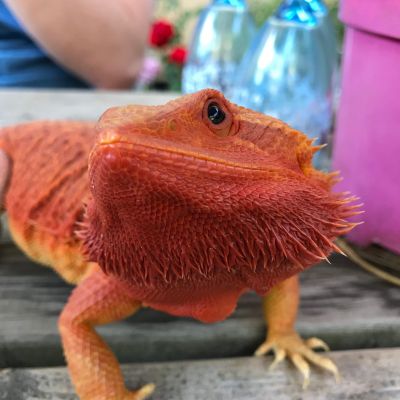
Posted By:
Dragons aren’t just a myth; they live amongst us, and require veterinary treatment too – bearded dragons, that is. These reptiles are one of the most popular exotic pets, and are probably the most common lizard presented to veterinary practice. Like all reptiles, bearded dragons have complex needs, and require a lot of time, money and dedication to keep happy and healthy. Dimple is one such bearded dragon, a two year old female who underwent a biopsy.
Dimple is usually quite a greedy lizard, and as such is a little overweight! When she wasn’t eating as well, her owner felt something must be wrong. At her large size of over a kilogram in weight, her preference of sitting on her owner’s shoulder, and her striking orange colour, Dimple is hard to miss and one of the most recognisable patients in the waiting room. Bearded dragons are usually sandy coloured, but there are various ‘morphs’ available – different mutations in colours and patterns, and Dimple is bright orange.
Dimple’s owners were very observant to her demanding needs and health, and had noticed that there seemed to be a lump in her mouth. She was quite stubborn, but with her owner’s reassurance it was possible to open her mouth and see a fleshy mass on the left hand side of her mouth, near the front of her gums. This could represent infection, inflammation, or even cancer. Dimple remained quite bright, but her appetite of greens and insects was reduced, with her owner resorting to tempting her with only the tastiest of creepy crawlies – morio worms, the larvae of beetle, resembling large mealworms.
A cotton bud couldn’t remove the area – it was firmly anchored to the gum. Initially, a course of anti-inflammatories and an antiseptic bathing regime, was prescribed but unfortunately had little effect. Antibiotics were started in case of bacterial infection, via an injection into the muscle of her back legs every few days. When the lump still wasn’t shrinking, a diagnosis was investigated for, requiring a biopsy. An excisional biopsy would obtain the tissue to send for laboratory analysis, and would remove most of the area that may have been causing a problem to Dimple. However this required a heavy sedation.
Dimple’s owners wanted to do everything they could for her, and were fortunately covered by pet insurance as well. Special ‘exotic’ pet insurance policies exist, from specialised insurance companies, and can help to cover the cost of procedures such as this. Dimple was admitted to the practice for the day, and settled into her vivarium to hospitalise reptile patients in the exotics ward. A sedation was given by injection into her tail vein, and she was sleepy and relaxed enough to allow her mouth to be opened fully. With a small amount of local anaesthetic, the lump was removed with a scalpel and forceps, and bleeding was controlled with cotton buds.
The lump was placed into a pot of formalin and posted to a specialised exotic species laboratory whilst Dimple slowly recovered from her sedation. She would wake up fully over the next day at home, and continued a course of antibiotic injections whilst awaiting results. Eventually, results revealed a diagnosis of gingivitis – inflamed gum tissue. Happily, there was no evidence of cancer cells, and no nasty infectious causes were identified. The removal of the tissue and course of medications should have been enough to be effective, and sure enough now the lump was out of the way, she didn’t appear to be as put off by her eating, and her appetite came back well. Dimple was now back to her best, and everyone was glad they could provide a thorough service to her, for her appetite’s sake!
Whilst on my visits I have been having several discussions...
As our feline friends get older there are a few conditions...
Another winter discussion group season is now behind...
©2024 Shepton Veterinary Group Ltd., All rights reserved.
Privacy Policy • Terms & Conditions • Cookie Policy